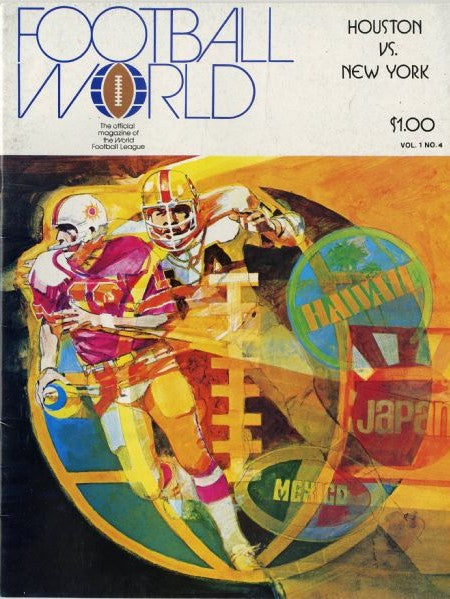The National Football League (NFL) was formed in 1920 as the American Professional Football Association. It adopted its current name in 1922. It had the pro football landscape all to itself until 1926 when the first of many challengers appeared to try and win the hearts and minds of fans. Indeed, roughly 10 other leagues formed in succeeding years to take on the NFL, most collapsing after only a few seasons.
Take 20% OFF shirts from these defunct football league collections with the code: defunctfootball Just click on an image to shop each collection:
That doesn’t include a few minor league circuits like the Atlantic Coast Football League and the Continental Football League, both of which operated with moderate success in the 1960s and 1970s. It also doesn’t include the Arena Football League, which went out of business in 2019. For the same reason, the much healthier Canadian Football League is left out, even though it dabbled in the American market in the 1990s.
Teams in these rival leagues have played in many different cities, of course, with some having had several clubs. Places like Memphis, Birmingham, and San Antonio are no strangers to new football leagues. However, do you know which city has had the most teams? Find out below.
AFL I
1926
Founded by Charles "C.C." Pyle, General Charles X. Zimmerman, and football megastar Red "The Galloping Ghost" Grange, this first NFL challenger consisted of nine teams. It was formed when Grange’s manager, Pyle, was turned down for an NFL franchise in New York as the Giants were just a year old then and objected. The NFL commissioner sided with the Giants and Pyle was rejected.
Undaunted, he formed the American Football League (AFL). The new circuit relied heavily on the drawing power of Grange who played for his manager’s New York Yankees. It wasn’t enough. A few teams folded after only a handful of games, as the rest of the league only completed one season.
AFL II
1935-36
The next NFL competitor, also called the American Football League, debuted in the fall of 1935 with eight teams. One of those clubs was the Cleveland Rams who left for the NFL after one year and later became the Los Angeles Rams, the St. Louis Rams, and the Los Angeles Rams again. The league’s first champion was the Boston Shamrocks.
The second AFL also featured the Los Angeles Bulldogs, an independent team who joined the league for the 1936 season after being rebuffed by the NFL. They won the 1936 AFL title with and 8-0 record and were the first pro sports franchise to be based on the west coast. The league, though, folded after that second season.
AFL III
1940–1941.
There was much confusion around the formation of the third American Football League. The organizers of the second AFL still held the rights to the name, or at least they claimed to. However, that didn’t stop the Midwest Professional Football League, then a minor league operation, from taking the name in 1939 and pressing forward with plans to become a major league starting in 1940. The AFL II folks were trying to restart their league but never got it back up and running.
Meanwhile, AFL III launched in the fall of 1940 with teams in Boston, Buffalo, Cincinnati, Columbus, Milwaukee, and New York. The Pittsburgh club from the previous AFL announced its plans early on to join but never did. Boston dropped out after one season, leaving five teams for 1941, which turned out to be the league’s final one. The Japanese attack on Pearl Harbor in December of 1941, which brought the U.S. into World War II, meant the end of the league, as many players went off to fight. Even the NFL struggled through the war but stayed in business.
AAFC
1946-1949
With the end of the war in sight in 1944, America’s thoughts began to turn to life after the conflict, as the end of World War II would also see the beginning of renewed prosperity in America. Several wealthy businessmen approached the NFL about buying expansion teams but the older league was not interested. Having survived the war, it wanted to keep its membership tight.
Instead, the rejected prospective owners were approached by Chicago Tribune sports editor Arch Wald who had previously established baseball’s All-Star Game and the College All-Star Game. The latter pitted the NFL Champion against a squad of top collegians.
Dubbed the All-America Football Conference, the new league hoped to establish itself as a second major football league and challenge the NFL champion in a sort of World Series of pro football. The NFL was not keen.
The league lasted for four years but was dominated by one team, the Cleveland Browns. Champions of all four seasons, they only lost three times and tied twice, across the league's entire history.
While the AAFC owners had deep pockets, many didn’t want to tough it out, especially with one team dominating the circuit. After the 1949 AAFC championship, it was announced that three teams from the league would join the NFL, with players from the remaining clubs being acquired by the older league's clubs.
AFL IV
1960-1969
The fourth time was a charm for a league calling itself the American Football League. And unlike the other leagues on this list, this one survived with all of its teams playing to this day.
Like the AAFC, the fourth AFL was formed by a group of men who had been spurned in their attempts to get NFL expansion franchises. In 1960, their new league kicked off with eight teams: New York, Los Angeles, Denver, Buffalo, Boston, Oakland, Dallas, and Houston.
The eight teams toughed it out, with only New York edging toward bankruptcy. New investors, though, were brought in to save that team and in 1966, the AFL merged with the NFL. They operated as two separate leagues until 1970 when they became one under the NFL banner.
WFL
1974-75
Feeling the NFL had grown complacent and was ready for new competition, sports entrepreneur Gary Davidson announced the formation of the World Football League (WFL) in late 1973. Davidson had previously started leagues to compete with the National Basketball Association and the National Hockey League.
The 12-team WFL began play in July of 1974 and drew pretty big crowds-- at first. It was quickly revealed that several teams had given away tickets to inflate attendance figures. Even the teams that had legitimate crowds couldn’t escape the negative perception.
The WFL, like previous leagues, had a mixture of owners ranging from the very wealthy, to the not very wealthy, to the not at all wealthy. Unfortunately, the latter made up the largest sector and the league collapsed in 1975 halfway through its second season.
Read more about the WFL here. There's also a great website dedicated to one of the league's teams, the Charlotte Hornets, as well as the entire league.
USFL
1983-85
The United States Football League opened for business eight years later but with a new wrinkle. The new league would play its games in the spring and avoid direct competition with the NFL. The idea had been proposed as far back as the mid-1960s by Dave Dixon, the man who helped bring the New Orleans Saints into the NFL in 1967.
The USFL tried to stick to a strict set of rules outlined by Dixon, notably not spending too much for star players. Of course, that didn’t last long. After one year, the 12 teams expanded to 18, bringing in an infusion of cash through expansion fees but diluting the product.
As with previous leagues, some teams did well while some did not. Unlike the WFL, though, most of the USFL teams were well run and capable of surviving a few tough years. They never got the chance. At the behest of one of their most outspoken owners, Donald Trump of the New Jersey Generals, the USFL decided to take on the NFL directly, starting in the fall of 1986.
It was hoped a lawsuit against the NFL would provide the needed funds to help the league survive. In reality, it was an attempt, to get the NFL to absorb at least a few of the USFL teams, much like the old AAFC, or gain a full merger like the AFL. It didn’t work. The USFL won the lawsuit but were famously awarded only $3 in damages, putting the league out of business.
WLAF/NFL Europe/NFL Europa
1991-2007
While the NFL disliked the USFL, they did seem to like the idea of playing in the spring and reducing the chances of another offseason rival. They also liked the idea of marketing the game overseas. Indeed, as early as 1974, the NFL thought about starting a six-team spring league in Europe but did not move forward with it.
In 1991, the World League of American Football League (WLAF) was launched as a developmental league of sorts for the NFL. The league had seven teams in North America and three in Europe. After the second season, the league’s operations were suspended.
In 1995, it was revived but with no teams in North America. The league, now based entirely in Europe, eventually changed its name to NFL Europe and later NFL Europa. The league sputtered along until 2007 when the NFL finally pulled the plug in the wake of dwindling interest.
XFL
2001
Wrestling magnate Vince McMahon founded the XFL, or Xtreme Football League, under the auspices of his World Wrestling Federation (today, the WWE). NBC was a partner and televised the league's games.
Playing in the spring like the USFL and WLAF/NFL Europe, the XFL promoted what it called “smashmouth football.” Several rule changes were implemented to increase the amount of action, and while early TV ratings were good, interest soon evaporated as did the league after just one season.
UFL
2009-2012
The United Football League (UFL) began in 2009 and was an odd little circuit. Never having more than five teams at any one time, it placed teams in cities that did not have an NFL franchise (except for the New York Sentinels who moved to Hartford after the inaugural 2009 season).
Unlike the previous four contender leagues, the UFL played its schedule in the fall. The league fought for attention not only with the NFL but high school and college football as well. It also was widely perceived as a second-tier league featuring players who had been cut by NFL teams. After four seasons, the league ceased operations.
AAF
2019
The Alliance of American Football (AAF) was another go at a spring league. Founded by TV producer Charlie Ebersol and former NFL executive Bill Polian, the AAF fielded eight teams and planned to play a 10-week schedule followed by a championship game. They only made it to week eight. Ten days into its season, Thomas Dundon, who owner the National Hockey League’s Carolina Hurricanes, invested a controlling interest in the league for $250 million.
He envisioned the AAF being a developmental league for the NFL. However the NFL Players Association balked over injury fears. Without their okay, the AAF could not have functioned effectively as a minor league for the NFL, so Dundon withdrew is financing and the league subsequently collapsed.
XFL II
2020
The second incarnation of the XFL was different in many ways from the 2001 edition. Most notably, the big time wrestling inspiration was dialed way back. Instead, passion for football was emphasized as reflected in the league’s tagline, “for the love of the game.”
Like the 2001 setup, the XFL II fielded eight teams though, oddly, only two cities returned from the first go round; New York and Los Angeles. Ratings for the first few weeks were encouraging but declined as the season went on. The league was forced to suspend operations, then fold completely. New business interests, though, are set to relaunch the league in 2023.
The city with the most teams:
The Bridesmaid Award goes to: Orlando with six. After hosting a team called the Panthers in the Continental and Atlantic Coast Football leagues in the mid 1960s through the early 1970s, Orlando welcomed its first major league team in 1974 with the arrival of the WFL’s Florida Blazers. The city went on to host teams in each of the successive rival leagues: The Orlando Renegades (USFL), the Orlando Thunder (WLAF), the Orlando Rage (XFL), Florida Tuskers (UFL), and the Orlando Apollos (AAF)
If you include the CFL’s American experiment of the mid-1990s, and count the WFL’s Americans and Vulcans as one team, Orlando is tied with Birmingham, Alabama for the most teams.
IMAGE: The Charlotte Hornets host the Birmingham Vulcans in a 1975 WFL game









